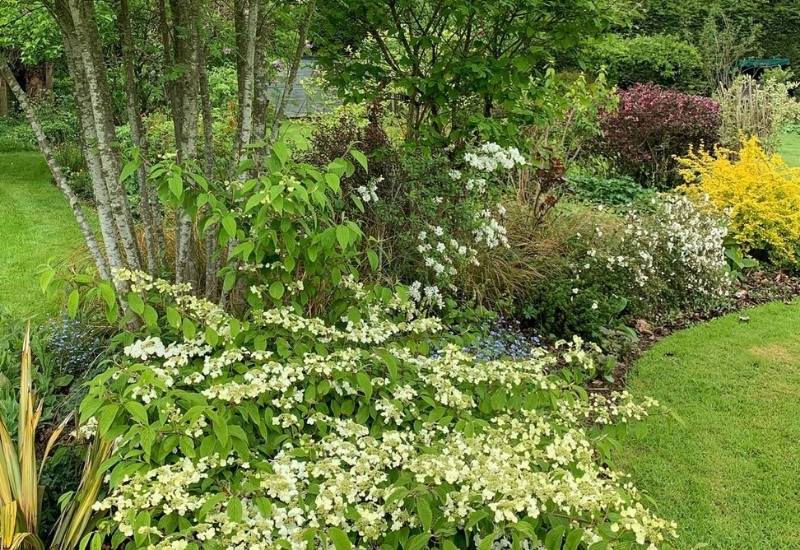
Shrubs with white flowers, deciduous or evergreen, can bring light, peace and even candor to your garden, borders, containers or as specimen planting.
You will find white flowering trees and bushes in many gardens, especially white gardens and moon gardens, but also in combination with other bloom and foliage colors. In fact, it’s hard to do without one or more bushy plants with white blooms in any design.
From the delicate beauty of a oak leaf hydrangea to the exuberance and vibrancy of gardenia, there are quite a few flowering shrubs with gorgeous snowy blooms that can add something special in your garden.
You can pick them based on their, blooming season, foliage color and maintenance needs. But what’s more important is to make the best of this color in order to create an attractive look for your green space!
Today, we’d like to share 12 of our favorite flowering shrubs with beautiful white blooms, each with tips, so you can fit them into your garden like a real artist.
The Color White In Gardens And Flowering Shrubs
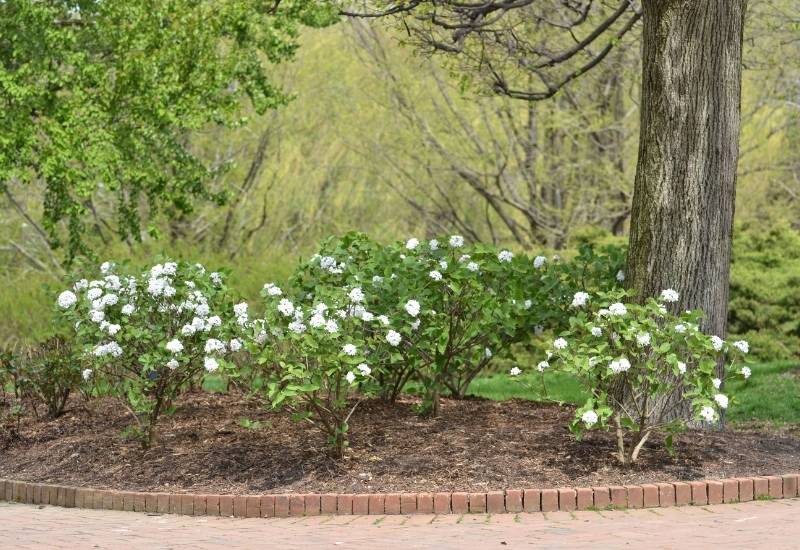
All colors bring emotions, feelings and an atmosphere to gardens and terraces and white is no exception. White gives a sense of peace and purity, but it also brings light and luminosity in your green space.
To appreciate white to its full extent, visit a moon garden, or white garden; these are green spaces, often just garden rooms where the flowers are all of the color of snow. The overall sense of relaxation and lightness is quite impressive.
Of course, it also has overtones and allusions to both childhood and wedding days, because of its reference to innocence.
But can we only use white on its own?
White Blooms on Shrubs and Their Foliage
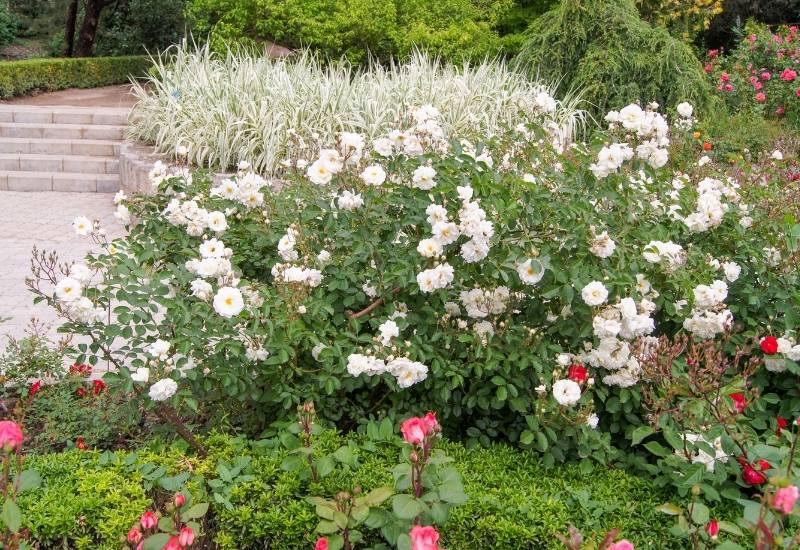
The answer is that it’s almost impossible to use “only white” because most shrubs come with foliage… It was a tricky question…
But white has a very “changeable” effect when set against different shades of green – more than other colors.
White against light green leaves gives a great sense of brightness and the contrast is delicate and fresh.
White against dark green gives you a sense of contrast between light and darkness; it is far more dramatic than against bright shades and the blooms become like “spotlights” of purity.
It still lightens up the garden, but the eye is drawn to the single flowers and inflorescences, rather than the overall effect and bush.
White against blue and silver leaves has a very strange effect; it looks like the whole shrub is a “unity” of brightness and light games, but the blooms will appear less visible.
So far with foliage, but there can be other bloom colors too…
Combine the White Blooms of Shrubs with Flowers of Other Colors
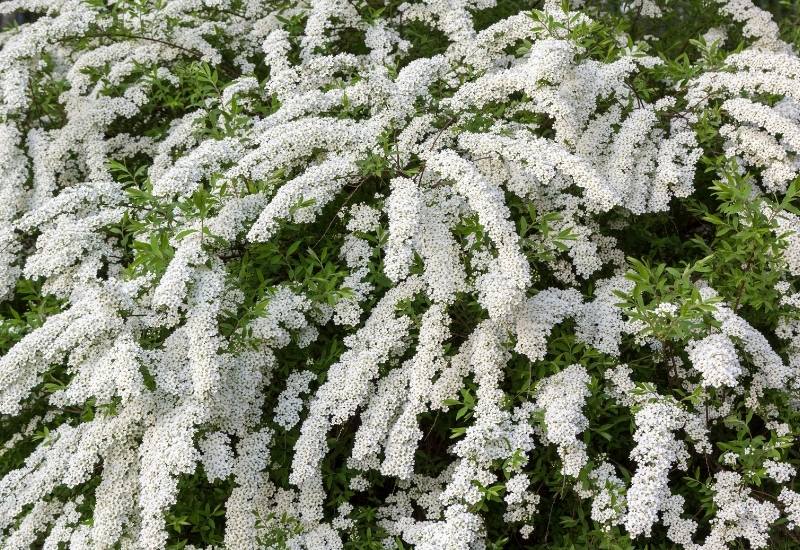
Flower color is an art, and sometimes it is hard to achieve. Unless you have a cottage garden, where all colors can be mixed randomly, you want to be careful with the flowers that bloom in your green space over the months. Some really don’t match, but white goes well with virtually any color.
Gardeners usually keep the bloom color range between to main colors, playing with the shades in between. But white can be an exception; you can easily add white as the third color in your range. In this respect, it counts a bit like the green of leaves…
If you want white as one of the two main colors, you can play it in tow ways: for harmony or for contrast.
White Flowering Shrubs for Color Harmony
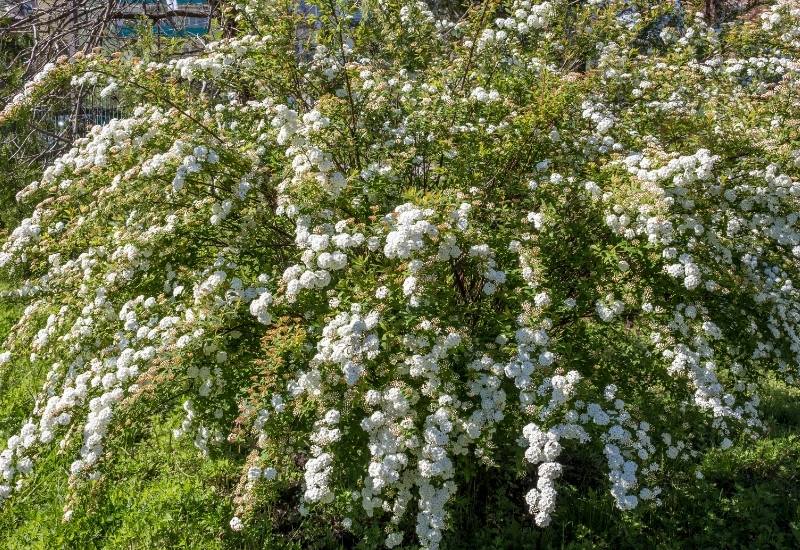
If you want a harmonic effect with your white blooming shrubs and other flowers, mix it with light colors, like pink, yellow, light blue and green. You can play with subtle differences between all the shades, going through the cream range etc.
But any two of these colors used together, even three with white, give a sense of balance and harmony, as well as brightness. Just picture them in your mind before you choose them.
But how about if you don’t want a delicate effect, and you want drama instead?
Use Them for Color Contrast
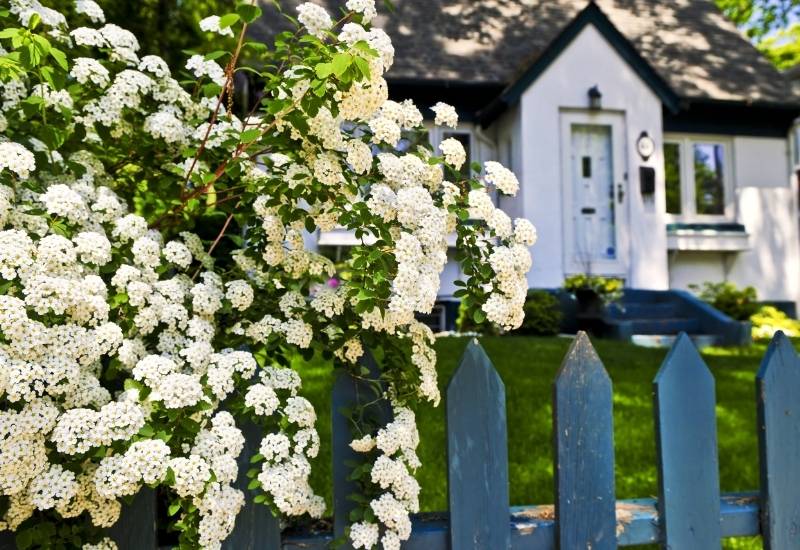
Color contrast gives eye catching effects, energy and drama to gardens and terraces. You can use white, as a color, to achieve this effect. Match it with strong, deep and saturated colors.
By “saturated” we mean “rich in pigment”, “dense”, like a shocking pink… Colors that have “a lot of color” in them, as opposed to pastel shades…
Also use the purest shades of white if possible, like snow white and pure white.
Thus, white and fiery red, golden yellow, deep blue, rich purple, bright orange (rather than peach, for example), maroon, velvet violet, “black” and deep magenta or shocking pink can give amazing bright contrast!
But if two is company, with white, three is a magic number.
Use the White of Flowering Shrubs as a Third Color
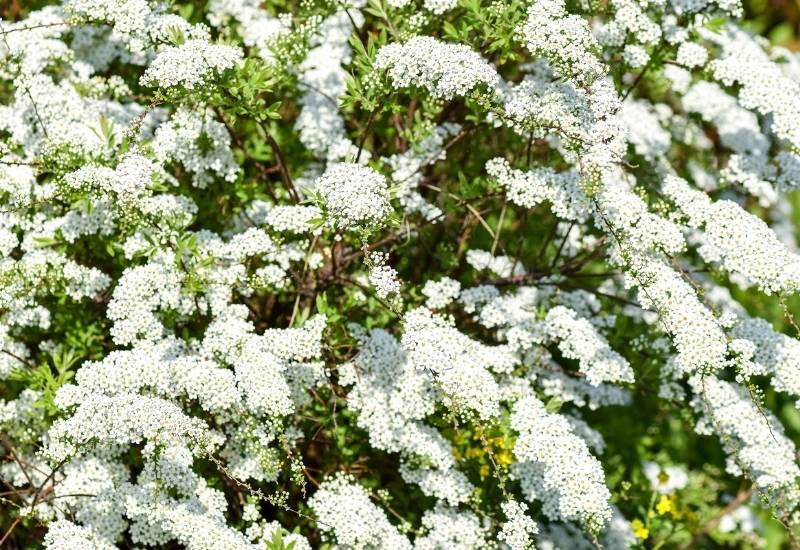
White is the safest color to use in combinations of three… Imagine it between light pink and light blue, or between orange and red. Then again, picture it between purple and violet or blue and violet…
You see, white can brighten up and soften the contrast between colors, and even function as a “bridge” between them. Talking about shrubs in particular, you can use their white blooms as backdrop to the color combination of other plants! A neutral background will give more “space” to the flowers in your beds and borders…
And now that you have become a professional “garden painter with white”, let’s see what our beautiful shrubs have to offer!
12 Striking White-Blooming Shrubs For Every Garden
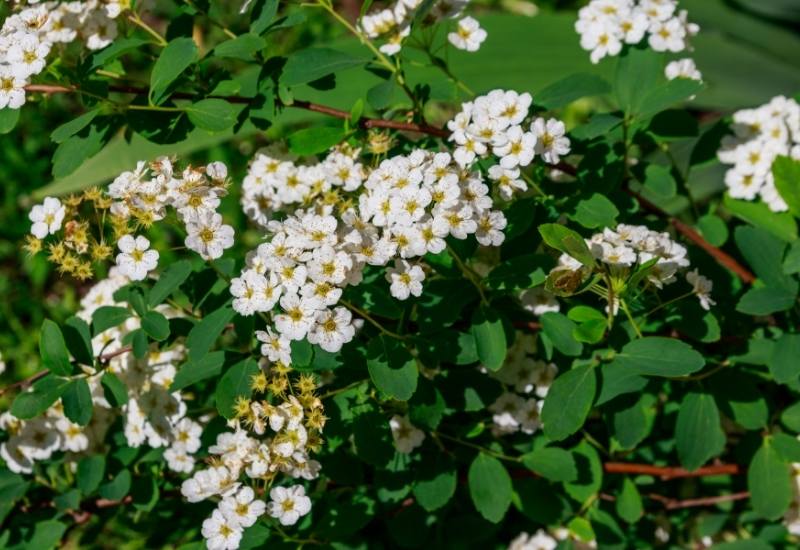
Ready now? Let’s get straight into it… Welcome our protagonists, the most beautiful white flowering shrubs ever, and remember we have picked at least one for each different need, setting, design… I trust you will find one that you love and that will grow well in your garden or balcony.
1: ‘Full Sail’ Hybrid Tea Rose (Rosa ‘Full Sail’)
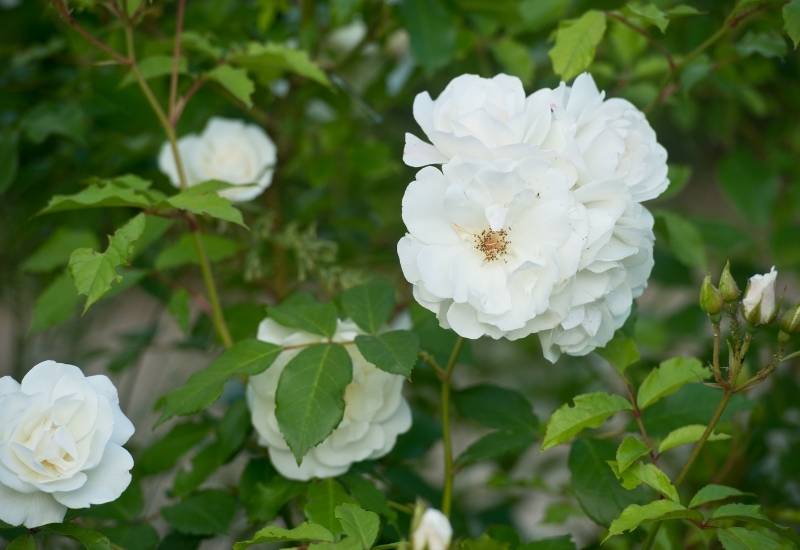
‘Full Sail’ is a medium sized shrub hybrid tea variety of rose with large and fully double pure white blooms. The elegant tea cup shaped blossoms will bloom repeatedly throughout the warm season, and they loom perfect against the shiny dark green leaves.
They can be 5 inches across, or 12 cm! We have chosen this cultivar out of the thousands available because it is very strong and almost disease free.
This way you can get a wonderful snow white rose without worrying about pests and ailments all the time.
‘Full Sail’ is an excellent choice for specimen planting, but you can also grow it in containers, as it is manageable in size.
It can work well in both formal and informal gardens. You will be amazed by the candid brightness of its white blooms!
2: English Hawthorn (Crataegus laevigata)
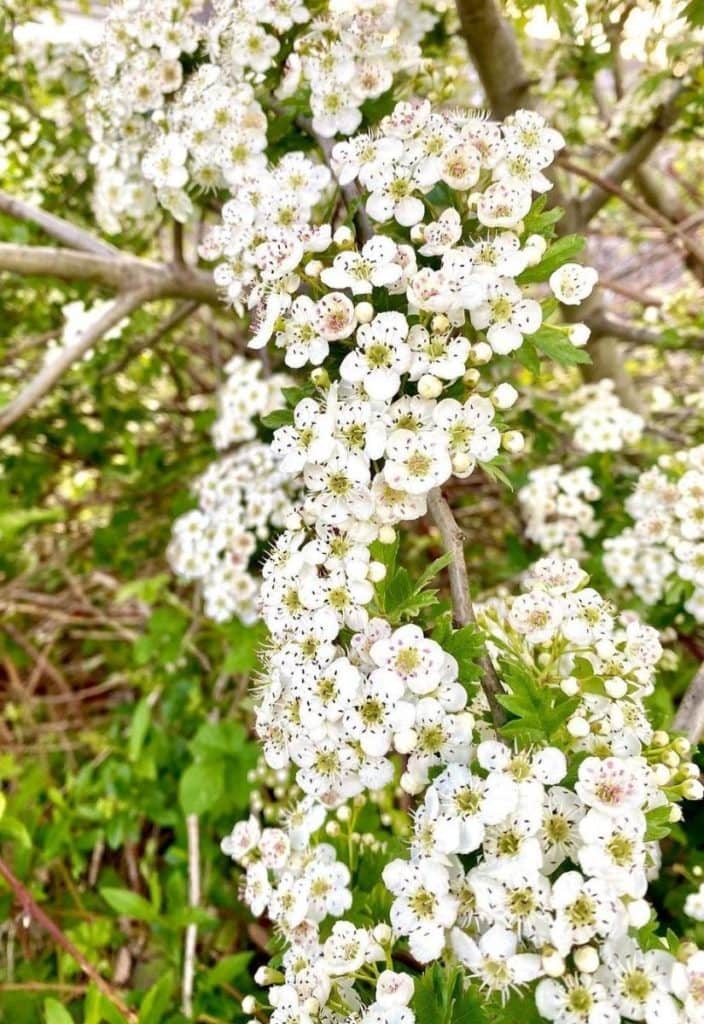
English hawthorn is a classic white flowering deciduous shrub – we may even venture to say the queen of white spring blooming shrubs! The delicate looking blooms are profuse and they look really fresh against the light green, thinly textured foliage.
They have five petals, and the pistils have magenta anthers, and they come in clusters (corycombs) all over the zig zagging branches.
This plant also plays another “color game” with white. The red fruit can appear when snow comes, in fact. Do note that the name is not random: it has long and painful thorns, up to 1 inch each (2.5 cm).
Hawthorn is ideal for hedges and for specimen planting; it is perfect for informal, traditional looking gardens, and, no need to say, ideal for English country gardens.
3: Oakleaf Hydrangea (Hydrangea quercifolia)
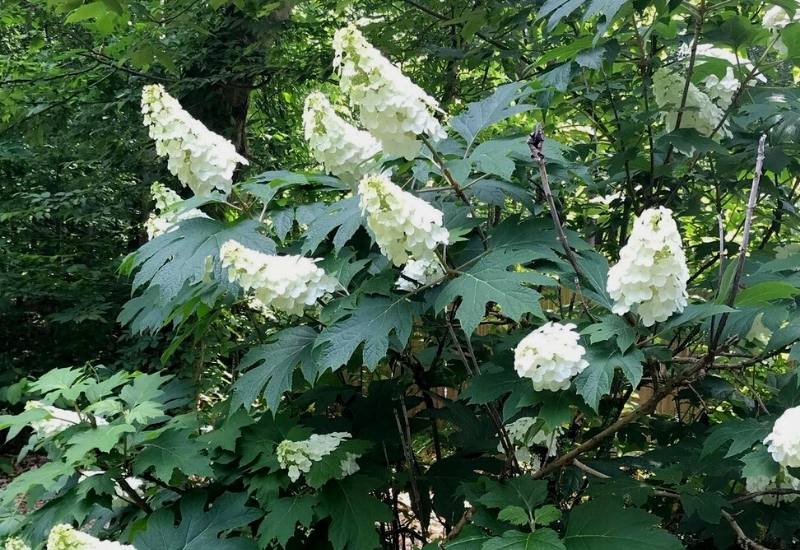
Oakleaf hydrangea is a deciduous shrub with a round habit, lush foliage and showy white inflorescences. These can be up to 1 foot long (30 cm), conical in shape and packed with beautiful white semi double flowers.
These will then turn light pink late in the season, but they last for months! While it is to all effects a hydrangea, it does not look like one.
The leaves, in fact are large and they have deep lobes, decorative on their own. They are rich light emerald green but they turn copper and red in fall.
This large shrub is ideal for spacious informal gardens and even public parks. It will provide interest from spring to fall, thanks to its cream white blooms but also its impressive leaves.
4: Serviceberry (Amelanchier alnifolia)
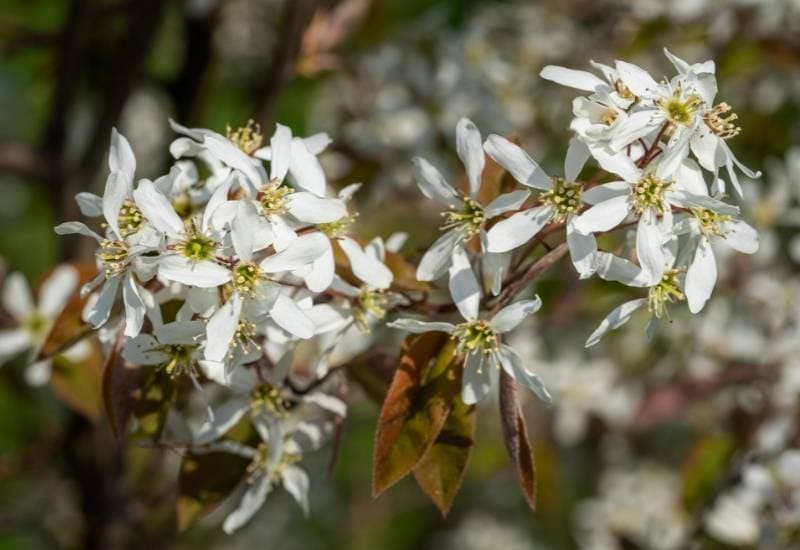
Serviceberry is a deciduous shrub with dark branches which will start blooming in spring, before the leaves appear.
The flowers are small, delicate looking and white – and they are plenty at the end of the branches, and fragrant!
Then, sweet rounded cordate green leaves start to appear to add a decorative dimension to this plant. Then, blue berries appear, keeping the show going till fall.
Serviceberry is a natural looking shrub, so it will look good in informal gardens, especially temperate looking ones; in fact it is very cold hardy! It can be used in hedges and even wind screens, or you can grow it as a specimen.
5: Koreanspice Viburnum (Viburnum carlesii ‘Compactum’)
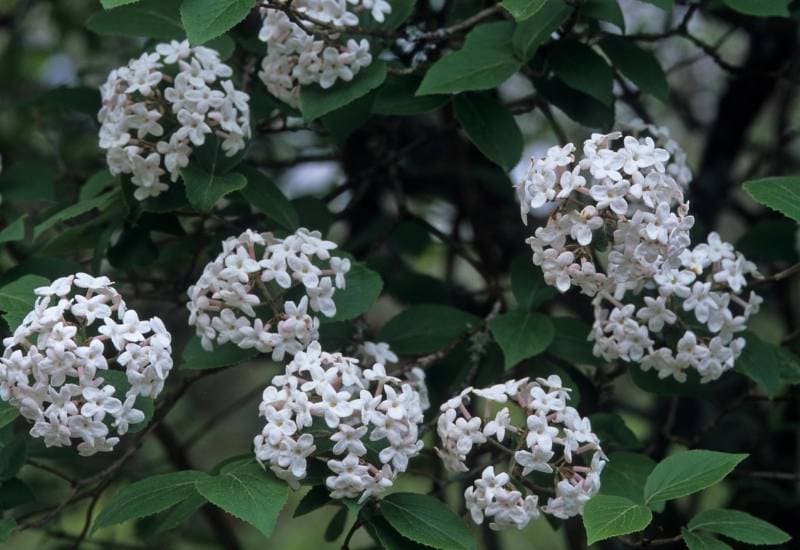
Koreanspice is a particular variety of viburnum, distinctive for its clusters of tiny pure white flowers. This way, even if you have a modest space, you can enjoy the pure white clusters of cinnamon scented blooms.
Other varieties have less pure shades, sometimes mixed with other colors, but this one is a guarantee of candor!
They look great against the light middle green ovate deciduous leaves, which are actually bronze when young. Then, fiery red berries will complete the show in the late months.
This small and round variety of viburnum is ideal for a natural looking garden, even in a small suburban setting, and it is small enough to grow in containers on terraces and patios.
6: Mountain Andromeda (Pieris floribunda)
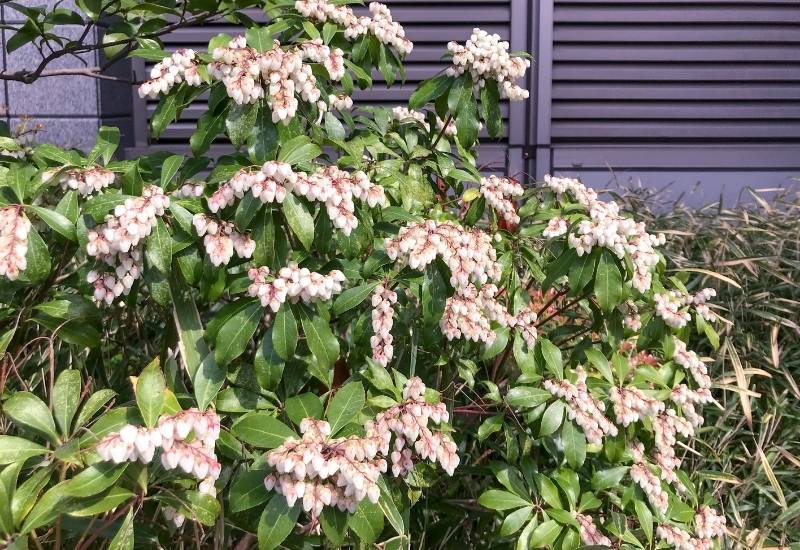
Mountain andromeda is an evergreen shrub closely related to the more famous Japanese Andromeda (Pieris japonica) but it has many advantages. The clusters of lantern shaped flowers are of a purer white shade, with tiny magenta pink dots.
They come on stem with opposite nodding blooms, and. The foliage is of a deeper, darker green than its cousin, giving you a bigger light and garden contrast.
Finally, it is much smaller, so you can grow it successfully if the space you have is modest.
This small Andromeda is an ideal plant for urban, suburban or other gardens to add flowers in the cold months, in borders, small hedges and even containers if you wish. It is also deer resistant!
7: American Elderberry (Sanbucus canadensis)
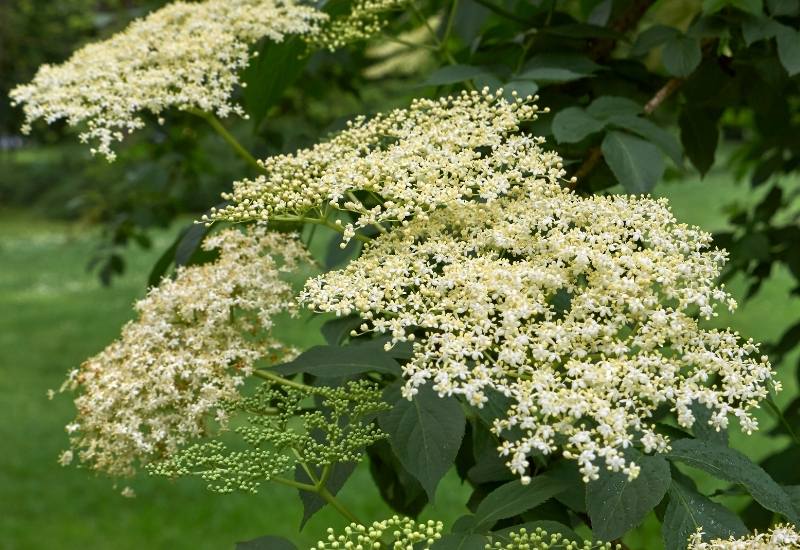
American elderberry is yet another classic deciduous and herbaceous looking large shrub with loads of white fragrant flowers.
Unlike other varieties, like Sambucus nigra, which has purple leaves and sometimes pink blooms, the American (Canaidan, actually) variety is a guarantee of purity of color.
And the foliage is light green, giving you that overall fresh and bright effect that you want at the back of gardens for light and happy feelings.
The blooms also have a frisk fragrance of lemon. Of course it will also regale you with the glossy (and edible!) black berries on red purple stalks in late summer and fall.
For this reason, it is ideal for large hedges or clumps, in informal gardens and even rural settings, like farms, for example. It won’t suit a formal setting; it has a very natural and wild looking presence.
8: Loblolly Baby (Gordonia lasianthus)
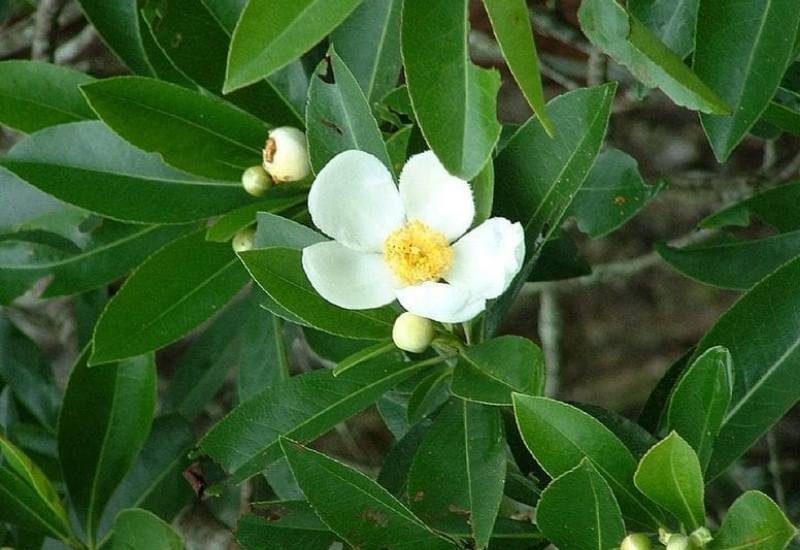
Loblolly baby is a lesser known evergreen shrub that can grow in wet areas as well! It is a beauty with glossy long elliptical leaves that range from mid to dark green similar to those of laurel.
The blooms come at the end of stems and they are large fragrant snow white flowers with 5 heart shaped petals and a bright saffron yellow ring of pistils in the center. These can be 3 inches wide (7.5 cm) and they are impossible to miss.
This shrub is a giant, and it can grow into tree size, so you will want it in a large garden, public park or for a very tall hedge, or maybe to crate a sheltered and shaded corner by the a pond or river in your garden which brightens up with a profusion of blooms all through the warm season. Yes, because loblolly baby is a marathon bloomer!
9: Gardenia (Gardenia jasminoides)
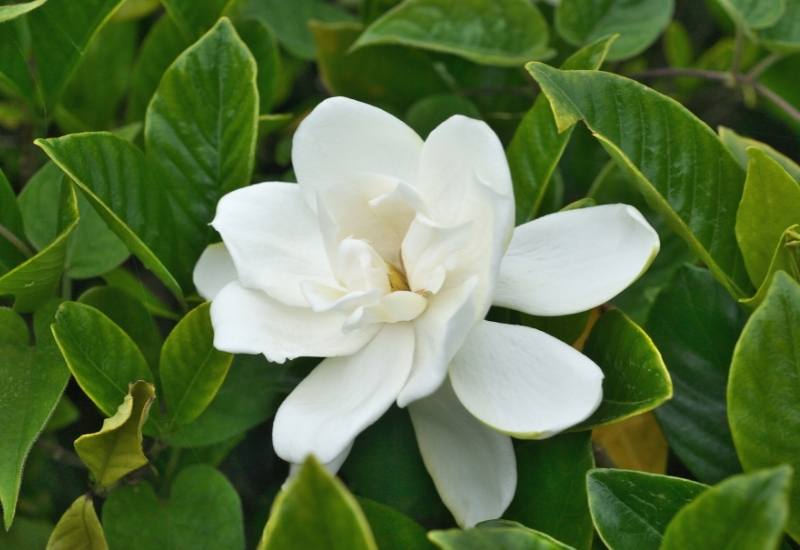
Gardenia is a classic white flowering evergreen shrub in gardens all over the world. There are many varieties, but “Cape jasmine” as it is called is a guarantee of super white rose shaped flowers that unfurl beautifully from the center.
The blooms can be huge in cultivars like ‘Aimee’, up to 5 inches wide (12 cm)! These are set against the dark, glossy oval foliage and they are fragrant too!
Gardenia is one of the world’s favorite flowering shrubs, and it is permanently associated to the color white. But it’s not the easiest to grow.
But if you do have the green thumb (and acidic soil…) do grow it in full soil or in containers; few plants can match its beauty!
10: Mock Orange (Philadelphus coronarus)
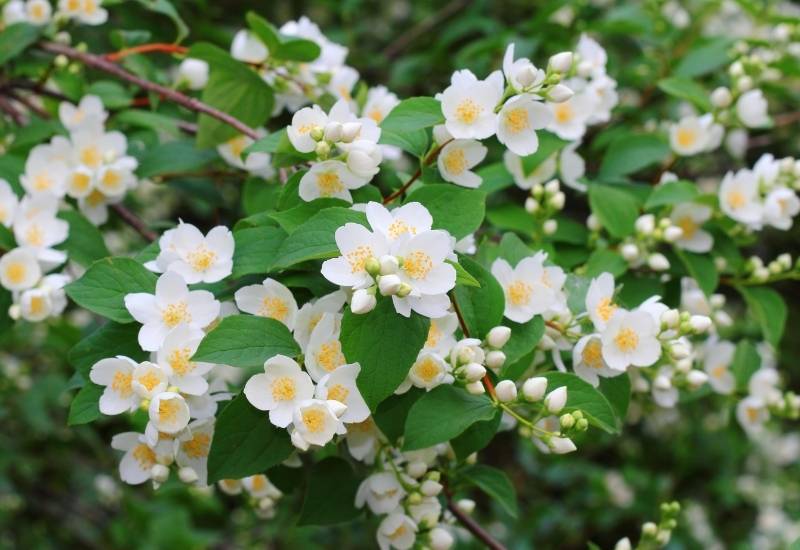
Mock orange takes its name from the pointed and light green elliptical leaves of this deciduous shrub, and the flowers are white, with 5 petals and bright yellow center.
These are about 1 inch in diameter (2.5 cm) and they are plenty all over the plant! What’s more, they are very, very fragrant indeed.
It is an excellent low maintenance large plant, which will give you lots of bright joy in exchange for very little effort.
Mock orange is ideal for large places and informal settings; large hedges, wind screens and at the back of sizable borders.
It can also sort out lots of problems in those areas of large gardens away from the main entrance, home… Those far away spots that need color, but you can’t give them too much of your time…
11: Summersweet (Clethra alnifolia)
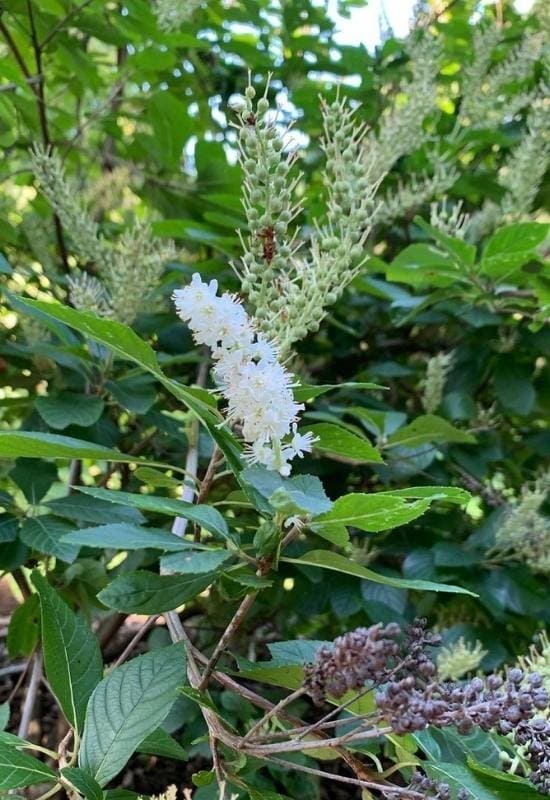
Summersweet is a Californian shrub with original tiny white blooms and great foliage. The inflorescences grow up like spikes of plumes of white flowers that open progressively from the bottom up.
And they are super fragrant! The leaves too point up and are broad, oval and mid to light green in color. In fall, though, the leaves turn golden yellow, adding a final dramatic blush to its performance.
In this, summersweet shares its beauty with you while it points to the sky, with a very uplifting effect.
Some cultivars now have pink or purple flowers, but the mother species is white. Even if it is from warm California, summersweet is very cold hardy, so it is also ideal for natural looking temperate gardens as well. Finally, it is one of the rare plants that can grow in full shade!
12: Camellia ‘Alba Plena’ (Camellia japonica ‘Alba Plena’)
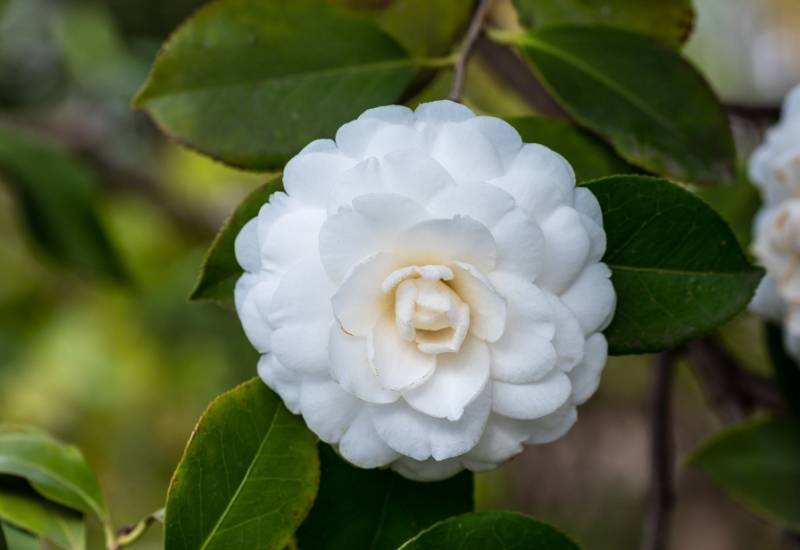
We have chosen ‘Alba Plena’ (“full dawn” translated) among all the white camellias because it has a record breaking and award winning flower. The blooms are huge, up to 4 inches wide (10 cm) and pure white.
But what makes them exceptional is the number of petals: up to 100 in each flower! They are also pointed, so you get a very sculptural rosette that looks like the marble decoration of a Gothic Cathedral.
Add the glossy evergreen leaves typical of this shrub and you understand why it has won the most prestigious gardening prize in the world, the Award of Garden Merit by the Royal Horticultural Society!
‘Alba Plena’ is a star camellia, which you can grow in a shaded spot in your garden to bring light, candor and sheer beauty where you so much need it.
But it is not an easy going plant; it too needs acidic soil and lots of care, or it may never reach its full potential.
White Flowering Shrubs for Every Garden
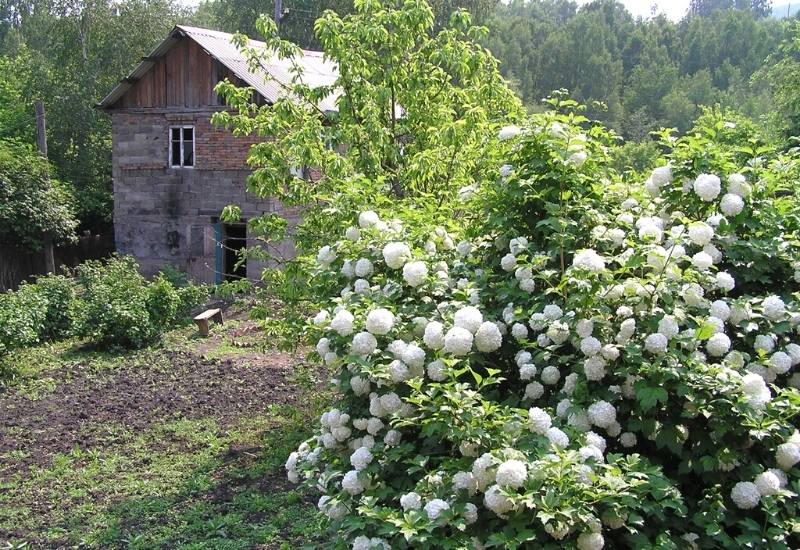
You have just seen the very top shrubs with white flowers. But look! Some are big, some are small, some for cold places, some for hot places, some tolerate dry soil, some tolerate boggy soil…
You see, we picked at least one for every need. And now you know all about how to use white blooming shrubs in gardens, come on, go ahead, tell us: which one is your favorite?

Written By
Adriano Bulla
After many years as an academic in London, Adriano Bulla became a writer, publishing books like A History of Gardening, Organic Gardening and Elements of Garden Design; he then decided to become a gardener, following his childhood dream, and has been following his dream writing and gardening professionally in Southern Europe, where he has specialized in new and innovative organic gardening fields and techniques, like permaculture, regenerative agriculture, food forests and hydroponics.
